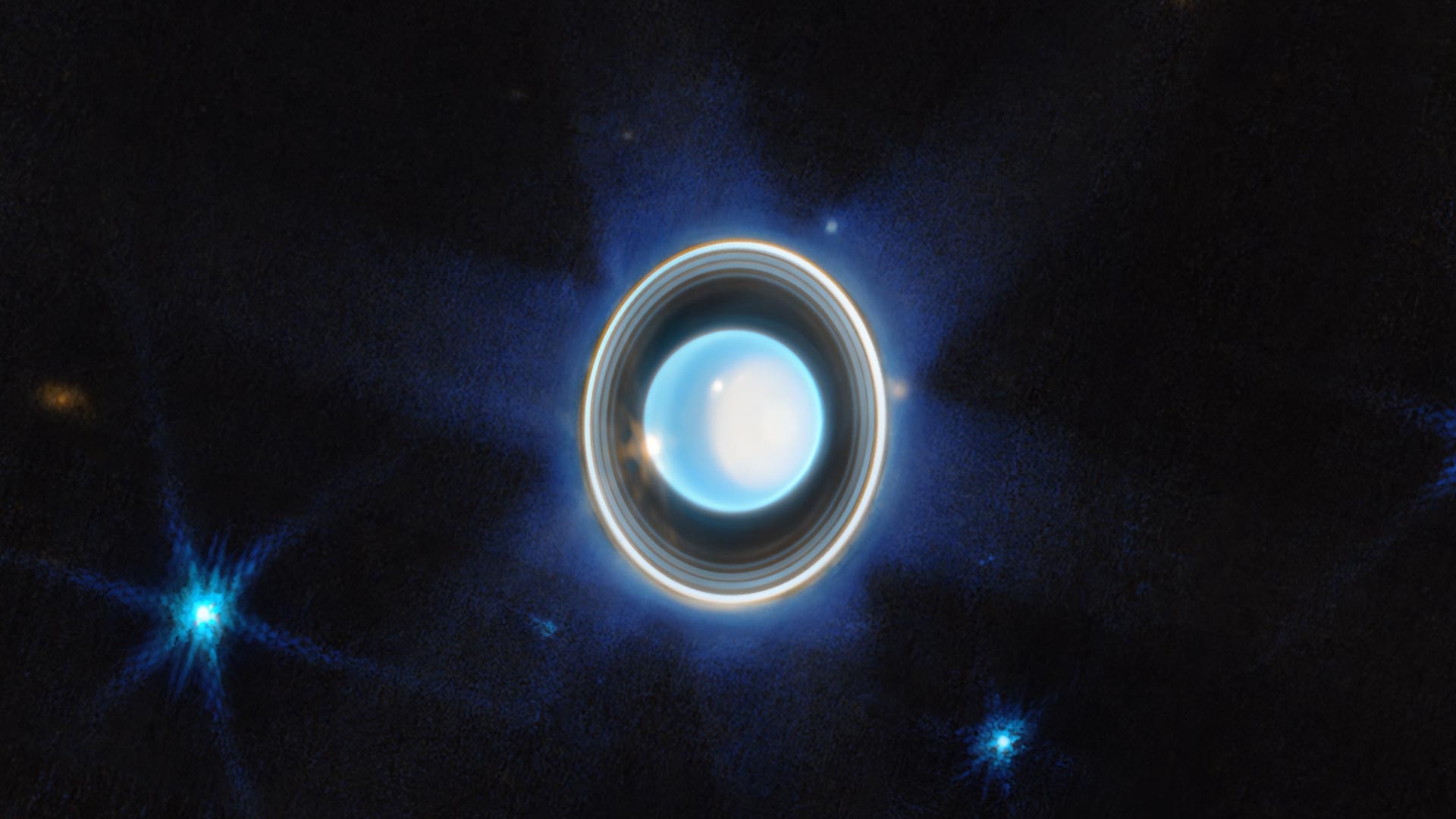Kredit: Věda: NASA, ESA, CSA, STScI, Zpracování obrazu: Joseph DiPasquale (STScI)
Webbův infračervený snímek zdůrazňuje dramatické prstence planety a dynamickou atmosféru
Vesmír[{“ attribute=““>Uranus is an oddball in our solar system, tilted on its side as it orbits the sun, causing extreme seasons. While the planet’s atmosphere appeared nearly featureless when visited by the Voyager 2 spacecraft in 1986, subsequent observations from the ground and in space have shown turbulent storms.
NASA’s James Webb Space Telescope recently observed Uranus, and the resulting image highlights a complex system of rings as well as a bright polar cap and likely storm clouds.

This zoomed-in image of Uranus, captured by Webb’s Near-Infrared Camera (NIRCam) on February 6, 2023, reveals stunning views of the planet’s rings. The planet displays a blue hue in this representative-color image, made by combining data from two filters (F140M, F300M) at 1.4 and 3.0 microns, which are shown here as blue and orange, respectively. Credit: Science: NASA, ESA, CSA, STScI, Image Processing: Joseph DePasquale (STScI)
Webb Space Telescope Scores Another Ringed World with New Image of Uranus
Following in the footsteps of the Neptune image released in 2022, NASA’s James Webb Space Telescope has taken a stunning image of the solar system’s other ice giant, the planet Uranus. The new image features dramatic rings as well as bright features in the planet’s atmosphere. The Webb data demonstrates the observatory’s unprecedented sensitivity for the faintest dusty rings, which have only ever been imaged by two other facilities: the Voyager 2 spacecraft as it flew past the planet in 1986, and the Keck Observatory with advanced adaptive optics.
The seventh planet from the Sun, Uranus is unique: It rotates on its side, at roughly a 90-degree angle from the plane of its orbit. This causes extreme seasons since the planet’s poles experience many years of constant sunlight followed by an equal number of years of complete darkness. (Uranus takes 84 years to orbit the Sun.) Currently, it is late spring for the northern pole, which is visible here; Uranus’ northern summer will be in 2028. In contrast, when Voyager 2 visited Uranus it was summer at the south pole. The south pole is now on the ‘dark side’ of the planet, out of view and facing the darkness of space.

This zoomed-in image of Uranus, captured by Webb’s Near-Infrared Camera (NIRCam) on February 6, 2023, reveals stunning views of the planet’s rings. On the right side of the planet, there’s an area of brightening at the pole facing the Sun, known as a polar cap. This polar cap is unique to Uranus because it is the only planet in the solar system tilted on its side, which causes its extreme seasons. A new aspect of the polar cap revealed by Webb is a subtle brightening near the Uranian north pole. At the edge of the polar cap lies a bright cloud as well as a few fainter extended features just northward of the cap’s edge, and a second very bright cloud is seen at the planet’s left limb. Such clouds are typical for Uranus in infrared wavelengths, and likely are connected to storm activity. Credit: Science: NASA, ESA, CSA, STScI, Image Processing: Joseph DePasquale (STScI)
This infrared image from Webb’s Near-Infrared Camera (NIRCam) combines data from two filters at 1.4 and 3.0 microns, which are shown here in blue and orange, respectively. The planet displays a blue hue in the resulting representative-color image.
When Voyager 2 looked at Uranus, its camera showed an almost featureless blue-green ball in visible wavelengths. With the infrared wavelengths and extra sensitivity of Webb we see more detail, showing how dynamic the atmosphere of Uranus really is.

This wider view of the Uranian system with Webb’s NIRCam instrument features the planet Uranus as well as six of its 27 known moons (most of which are too small and faint to be seen in this short exposure). A handful of background objects, including many galaxies, are also seen. Credit: Science: NASA, ESA, CSA, STScI, Image Processing: Joseph DePasquale (STScI)
On the right side of the planet, there’s an area of brightening at the pole facing the Sun, known as a polar cap. This polar cap is unique to Uranus – it seems to appear when the pole enters direct sunlight in the summer and vanish in the fall; these Webb data will help scientists understand the currently mysterious mechanism. Webb revealed a surprising aspect of the polar cap: a subtle enhanced brightening at the center of the cap. The sensitivity and longer wavelengths of Webb’s NIRCam may be why we can see this enhanced Uranus polar feature when it has not been seen as clearly with other powerful telescopes like the Hubble Space Telescope and Keck Observatory.
At the edge of the polar cap lies a bright cloud as well as a few fainter extended features just beyond the cap’s edge, and a second very bright cloud is seen at the planet’s left limb. Such clouds are typical for Uranus in infrared wavelengths, and likely are connected to storm activity.
This planet is characterized as an ice giant due to the chemical make-up of its interior. Most of its mass is thought to be a hot, dense fluid of “icy” materials – water, methane, and ammonia – above a small rocky core.
Vesmírný dalekohled Jamese Webba zachytil úžasný snímek další ledové obří planety sluneční soustavy, Uranu. Nový snímek obsahuje vzrušující prstence i jasné útvary v atmosféře planety. Webbova nová data pro Uran poskytují pozoruhodnou citlivost a odhalují nejslabší z prachových prstenců. Sedmá planeta od Slunce, Uran, je lichá: otáčí se na své straně v úhlu asi 90 stupňů od roviny své oběžné dráhy. To způsobuje neobvyklá roční období, protože póly planety zažívají 42 let nepřetržitého slunečního světla a 42 let úplné tmy (Uran obíhá kolem Slunce 84 let). V současné době je pozdní jaro na severním pólu, který je na pravé straně tohoto obrázku; Severní léto bude na Uranu v roce 2028.
Uran má 13 známých prstenců a 11 z nich je vidět na tomto webovém obrázku. Některé z těchto prstenů jsou s Webbem tak jasné, že když jsou blízko u sebe, zdá se, že splývají ve větší prsten. Devět je klasifikováno jako hlavní prstence planety a dva jsou slabé prachové prstence (jako je difúzní prstenec Zeta nejblíže planetě), které nebyly objeveny až do průletu Voyageru 2 v roce 1986. Vědci očekávají, že budoucí Webbovy snímky Uranu odhalí dva slabé vnější prstence, které byly Zjistěte to s Hubbleem Během 2007 kruhového přeletu roviny.
Webb také zachytil mnoho z 27 známých měsíců Uranu (většina z nich je příliš malá a slabá, než aby je zde bylo možné vidět); Na širokoúhlém snímku je identifikováno šest nejjasnějších. Toto byl jen krátký 12minutový expoziční snímek Uranu s pouze dvěma kandidáty. Je to jen špička ledovce toho, co Webb dokáže při pozorování této tajemné planety. Nyní probíhají další studie Uranu a další jsou plánovány v prvním roce Webbova vědeckého provozu.
V roce 2022 určily Národní akademie věd, inženýrství a lékařství vědu o Uranu jako prioritu v planetárních vědách a astrobiologii na období 2023–2033. Sken mého uzlu.
Vesmírný dalekohled Jamese Webba je přední světová observatoř pro vesmírnou vědu. Odhalí tajemství naší sluneční soustavy, prozkoumá vzdálené planety kolem jiných hvězd a prozkoumá tajemné struktury a počátky vesmíru a naše místo v něm. Program je výsledkem spolupráce mezi NASA, Evropskou vesmírnou agenturou (ESA) a Kanadskou vesmírnou agenturou a je řízen NASA.

„Unapologetický analytik. Rozzuřeně skromný kávový evangelista. Hráč. Nelze psát s boxerskými rukavicemi. Student. Podnikatel.“
You may also like
-
Kompenzace spánku o víkendech může snížit riziko srdečních onemocnění o pětinu – studie | Srdeční onemocnění
-
Cesta miliardáře do vesmíru je „riskantní“
-
V lasvegaské krajské věznici byl hlášen případ planých neštovic
-
Nejvýkonnější dalekohled na Zemi zachycuje snímky černých děr v nebývalých detailech
-
Havárie asteroidu NASA Dart opravdu pokazila jeho vesmírný skalní cíl

